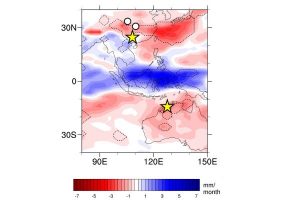
The journal Scientific Reports just published research by Cornell College Professor of Geology Rhawn Denniston.
The research focuses on the summer rains of Australia and Southeast Asia, which are linked together into the largest monsoon system on the planet. The zone across which these rains fall is called the tropical rain belt and is a region of enormous biological diversity and home to nearly 40% of the global population. This new study helps understand past changes in the width of the tropical rain belt and reveals previously unidentified links between the two continents.
The article is titled, “Expansion and Contraction of the Indo-Pacific Tropical Rain Belt Over the Last Three Millennia.”
The article looks at the monsoon rains that fell in northern Australia over the past 3,000 years. A research team, led by Denniston, explored the rainfall amounts by looking at the isotopes of oxygen in stalagmites.
“The ratio of these isotopes changes depending on the intensity of the rain,” Professor Denniston said. “As the water infiltrates into caves as dripwater, stalagmites forming from this water preserve the same isotopic ratios. By sampling the stalagmites, we are able to see past rainwater ratios. We also date the stalagmites very precisely by drilling out select areas and measuring the ratio of uranium to thorium, which tracks the age.”
The team discovered that changes to the monsoon in northern Australia matched up with monsoon variations in southern China, in some cases at quite fine temporal scales. Denniston attributes these changes to the movement and size of the tropical rain belt.
“The vast majority of models and studies have argued that the whole tropical rain belt shifted north or south as a coherent package through time,” Denniston said. “What our data suggest is that the tropical rain belt operates more like an accordion, expanding during some times, in which case both Australia and China get wetter, and contracting during others, in which case both Australia and China get drier. What’s particularly interesting is that climate models of the last millennium also support this result.”
Caroline Ummenhofer of Woods Hole Oceanographic Institution in Massachusetts performed the climate modeling, and KJ Passaro, a Cornell College alumnus, worked on this project for his honors thesis in geology. Denniston and Cornell College students performed the dating at the University of New Mexico with Yemane Asmerom and Victor Polyak. The stable isotope analyses were performed with Alan Wanamaker at Iowa State University.
This study formed the basis for a National Science Foundation grant of $350,000 to continue this work. The grant provides support for Cornell College undergraduate training, including fieldwork in Australia, lab work at University of New Mexico and Iowa State University, and modeling with Ummenhofer at Woods Hole Oceanographic Institution.
Denniston said the research team’s goal in the next stage of this project is to see if, and how, the accordion-like behavior of the tropical rain belt occurred over the last 9,000 years.
Reference:
Rhawn F. Denniston, Caroline C. Ummenhofer, Alan D. Wanamaker, Matthew S. Lachniet, Gabriele Villarini, Yemane Asmerom, Victor J. Polyak, Kristian J. Passaro, John Cugley, David Woods, William F. Humphreys. Expansion and Contraction of the Indo-Pacific Tropical Rain Belt over the Last Three Millennia. Scientific Reports, 2016; 6: 34485 DOI: 10.1038/srep34485
Note: The above post is reprinted from materials provided by Cornell College.










